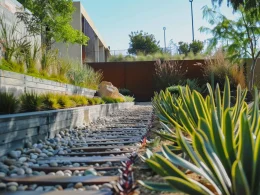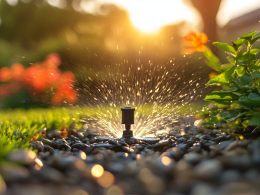Maintaining a lush, green lawn can be a constant battle for many homeowners in northern climates. Traditional lawn care services, including regular grass cutting, leaf removal, and frequent applications of grass fertilizer, can be time-consuming and expensive.
However, there’s a growing trend towards low-maintenance lawn alternatives offering aesthetic appeal and sustainability. These options reduce the need for intensive lawn care services and provide environmental benefits and cost savings in the long run.
Understanding Low-Maintenance Lawn Alternatives
Low-maintenance lawn alternatives are sustainable landscaping options that require minimal upkeep compared to traditional grass lawns. These alternatives often involve native plants, ground covers, or hardscaping elements that are well-adapted to local climate conditions.
By reducing the need for frequent mowing, watering, and chemical treatments, these options offer significant environmental benefits, including water conservation and increased biodiversity.
While the initial installation may require the expertise of a landscaping architect or designer, the long-term cost savings on lawn care services make these alternatives an attractive option for many homeowners.
Top Low-Maintenance Lawn Alternatives for Northern Climates

Groundcovers
- Creeping Thyme: This low-growing herb forms a dense mat that can withstand light foot traffic.
- Moss: Ideal for shady areas, moss requires no mowing and minimal care.
- Barren Strawberry (Waldsteinia fragarioides): A hardy perennial that spreads quickly and offers attractive foliage and flowers.
Native Grasses and Sedges
- Fescues: These cool-season grasses require less water and fertilizer than traditional lawn grasses.
- Carex species: Many sedges are well-adapted to northern climates and can create a lush, grass-like appearance with minimal care.
Clover and Other Flowering Options
- White Clover: This nitrogen-fixing plant can eliminate the need for lawn fertilizer service.
- Micro Clover: A smaller variety that blends well with grass seeds for a diverse, low-maintenance lawn.
Hardscaping Elements
- Gravel or Pebble Gardens: These can be designed by a landscaping architect to create attractive, no-mow areas.
- Patios and Decks: Expanding hardscaped areas can reduce the overall lawn space requiring maintenance.
Transitioning from Traditional Lawn to Alternatives
When transitioning to a low-maintenance alternative, start with a thorough site assessment. Consider factors like sunlight, drainage, and soil type. This is where the expertise of a landscaping design professional can be invaluable. They can help you choose the right alternatives for your space and climate.
Preparation is key. You may need to remove existing grass using solarization or sheet mulching methods. Some homeowners opt for a lawn dethatching service or rent a grass dethatcher to prepare the soil. Sometimes, a lawn core aeration service might be beneficial before planting new alternatives.
While transitioning to a low-maintenance lawn alternative can be exciting, the process can also feel overwhelming for many homeowners. This is where professional lawn care and landscaping services can be invaluable. Companies like Phoenix Pro Landscaping offer expert guidance and services to help you make the switch seamlessly.
Their team of experienced professionals can assist with everything from initial design concepts to final implementation, ensuring that your new low-maintenance landscape looks beautiful, functions well in your specific climate, and meets your unique needs.
Whether you’re looking to incorporate native plants, install water-efficient irrigation systems, or create a perfect balance of hardscaping and green spaces, professional landscapers can turn your vision into reality while adhering to best practices for sustainability and local regulations.
Maintaining Your Low-Maintenance Lawn Alternative

While these alternatives require less care than traditional lawns, some maintenance is still necessary:
- Watering: Most alternatives need less water than traditional lawns, but regular watering may be necessary during establishment.
- Mowing and Trimming: Some alternatives like native grasses may need occasional trimming, but far less frequently than regular grass cutting.
- Weed Management: While many alternatives naturally suppress weeds, some manual weeding may be required.
- Seasonal Care: In northern climates, some alternatives may benefit from mulching or protection during harsh winters.
Combining Different Alternatives for a Diverse Landscape
A landscaping architect can help you create a design that combines various low-maintenance options. This approach can create visual interest while providing different functional areas in your yard. For example, you might use clover in areas that get foot traffic, sedges in wetter areas, and gravel paths to connect different sections.
Addressing Common Concerns
Durability is often a concern when considering lawn alternatives. While some options may not withstand heavy foot traffic, many are surprisingly resilient. It’s important to choose the right alternative for each area of your yard based on its use.
Before making significant changes, check local regulations and HOA rules regarding landscaping. Some areas have restrictions on the percentage of yard that can be non-traditional lawn.
Case Studies: Successful Low-Maintenance Lawns in Northern Climates
Many homeowners and public spaces in northern climates have successfully implemented low-maintenance alternatives. For example, a Minnesota homeowner replaced their traditional lawn with a mix of native fescues and wildflowers, eliminating the need for a regular lawn moving service and reducing their water usage by 60%.
Environmental Impact

The environmental benefits of low-maintenance lawn alternatives are significant. They typically require less water, reducing strain on local water resources. The reduced need for mowing means lower emissions from lawn equipment. Many alternatives also support local wildlife and pollinators, increasing biodiversity.
These alternatives often eliminate the need for chemical fertilizers and pesticides. Instead of relying on a lawn fertilizer service, many homeowners find that compost or organic mulch is sufficient for their alternative lawns.
In Summary
Low-maintenance lawn alternatives offer a sustainable, cost-effective option for homeowners in northern climates. While they may require an initial investment in design and installation, the long-term savings on traditional lawn service and lawn care services make them an attractive option. Moreover, these alternatives offer significant environmental benefits, from water conservation to increased biodiversity.
If you’re tired of constant grass cutting and leaf removal, consider exploring these alternatives. Consult with a local landscaping design professional or lawn seeding service to discuss options suitable for your specific climate and needs. With the right approach, you can create a beautiful, sustainable landscape that requires minimal upkeep while providing maximum enjoyment.











